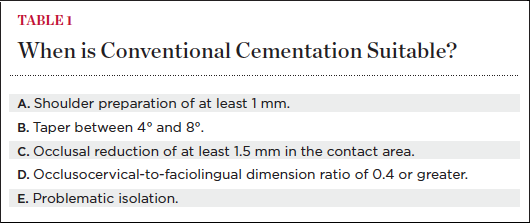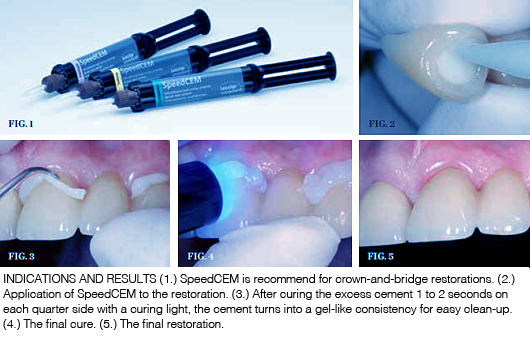SpeedCEM®
System eliminates the need for preparation conditioning.
SpeedCEM® is recommended for crown-and-bridge restorations where adequate retention and resistance form exists in the preparation design. SpeedCEM speeds up cementation procedures and eliminates the need for conditioning tooth preparations and applying bonding agents. Indicated for all situations where conventional cementation is suitable (Table 1), the system offers faster and easier processing than traditional conventional cements.
Fast
SpeedCEM is packaged in a double-push syringe with an automix tip that allows for direct application into the restoration (Figure 1). There is no need for additional accessories or mixing devices. Simply dispense the amount of cement desired for a perfect mix every time.
- No etching with phosphoric acid
- No primers or bonding agents needed
- No hand mixing required
- No mixing capsules
- No capsule activators, mixing devices, or injections
- No waste—only the amount of material required is dispensed
Versatile
SpeedCEM is indicated for the conventional cementation of indirect restorations made of:
- Metal and metal-ceramics
- High-strength all-ceramics (zirconium oxide, lithium disilicate, and aluminum oxide)
- Fiber-reinforced composite posts
Ivoclar Vivadent recommends Speed CEM for the “conventional” cementation of IPS e.max restorations (in situations where “conventional” cementation is suitable.) As the makers of IPS e.max, Ivoclar Vivadent also recommends that all IPS e.max restorations are etched with HF acid and silanated prior to placement using any resin-based cement, including self-adhesive resin cements. This technique will improve bond strengths to the lithium-disilicate, provide a better marginal seal, and improve overall performance.
Reliable
The acidic adhesion promoter (MDP) provides true self-adhesion to enamel, dentin, and most restorative surfaces, eliminating the need for additional primers or bonding agents.
SpeedCEM is easier to use than conventional cements and offers the additional benefits of resin-based cements:
- Superior physical properties
- High-level radiopacity
- Self-cure and light-cure options
- Adhesion to dentin and enamel
- Shade and translucency options
- Easier removal of excess
- Lower water solubility
SpeedCEM is available in three shades (Transparent, Opaque, and Yellow) with varying degrees of translucency for enhanced esthetic options. Based on the proven formulation of Multilink Automix, SpeedCEM offers superior material properties compared to other self-adhesive resin cements and conventional cements.
Clinical Application
Apply IPS Ceramic Etching Gel (5% HF acid) to the bonding surface of the restoration. Allow it to react for 20 seconds for IPS e.max lithium disilicate. Rinse thoroughly and air dry. (Note: This step is generally performed by the laboratory.)
Next, apply Monobond Plus to the bonding surface of the restoration. Allow it to react for 60 seconds and then air dry.
Apply SpeedCEM cement directly into the restoration (Figure 2), and seat.After seating, light-cure each quarter surface for 1 to 2 seconds. The cement will achieve a gel-like consistency for easy cleanup (Figure 3).
To achieve the final cure, use the Liquid Strip to eliminate the oxygen-inhibited layer (optional). Light-cure all margins for 20 seconds (Figure 4). Lastly, polish the restoration margins using silicone polishers and interproximal polishing strips for optimal results (Figure 5).
Disclaimer
The preceding material was provided by the manufacturer. The statements and opinions contained therein are solely those of the manufacturer and not of the editors, publisher, or the Editorial Board of Inside Dentistry.
For more information, contact:
Ivoclar Vivadent
Phone: 800-533-6825
Web: www.ivoclarvivadent.com





